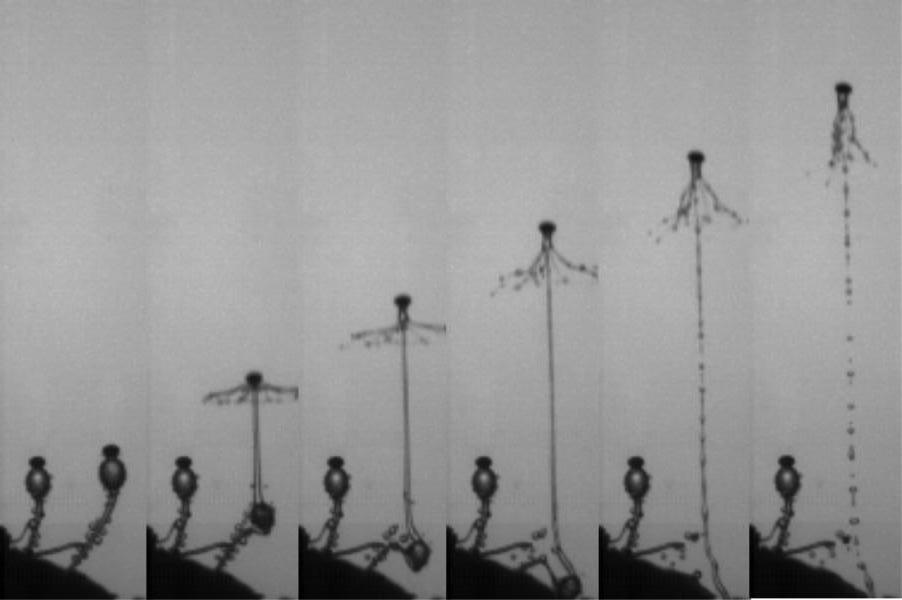Mushroom gamet has the fastest flight in nature
Phytoplankton has helped turn our planet into an ideal habitat by decomposing billions of tons of excreta released by herbivores. But it also has its own problems: its existence depends on the process of the gametophyte being eaten by herbivores and some animals when they eat grass growing near their feces.
Evolution has overcome this obstacle by creating a series of fungal ejection mechanisms, making it a tiny circus with launchers, trampoline and water spray guns.
An article was written by Nik Money Laboratory of Miani University (Oxford, Ohio) in collaboration with Diana Davis and Mark Fischer of Mount St. School. Joseph (Cincinnati) discovered the mechanism of action of a water spray gun that was responsible for firing gametes more than 2 meters away.
The researchers used high-speed cameras to capture 250,000 images in a second to capture this extremely fast-moving image. The gamet is launched at a maximum speed of 25m / s - impressive speed for the cell can only be observed on a microscope - equivalent to an acceleration of 180,000 g. Talking about acceleration, this is the fastest movement in nature.
The article published the discovery has many important meanings. Because this is the first study to use high-speed camcorders to obtain an image of the gamete discharge event in ascomycete and zygomycete mushrooms. Previous researchers only relied on models to predict parameters and gave false estimates of speed and acceleration. They then used conjecture to give an opinion that the pressure in the gameton was very high. Mushroom cells can create pressure by osmosis . In the study published in PloS ONE, the authors used a combination of spectrophotometric methods to detect chemical compounds that pull water into the gun.

Cysts are released in the mushroom Pilobolus kleinii.The illustrated video is made up of 6 different images captured by the camera at 50,000 frames per second.The selected image blends from the 10th picture, each one is 20 milliseconds apart.The follicular ejection process is complete in less than 0.25 milliseconds, 400 times faster than a wink that takes 100 milliseconds.(Photo: Yafetto et al)
The above experiments show that the mechanism of the gametocyte release is energized by the specific pressure of the cell combined into the mushroom population. Therefore, the long-haul flight of gametes does not only originate from each high pressure, but also from the explosion pressure lost when the gamet is released. There seems to be a similarity between the ejection phenomenon with the phenomenon of ink droplets being ejected from the inkjet printer.
Another important aspect of the study is that it allows researchers to test different models of mucus's effect on small molecules and they can find limitations in previous model setting method. Information on gamete ejection is important for future biophysical studies of gamete motion and pollen, which are very significant in the field of controlling plant diseases, terrestrial ecology, substances. indoor air intake, atmospheric science, veterinary medicine and biological simulation.
The study was conducted in collaboration with 6 students and 3 graduate students. They are people who have spent hundreds of hours getting the video. Some videos are so beautiful that students Haylay Kilroy (one of the co-authors) has dubbed the movie into music and intends to upload it to YouTube.
Research on fungal gamete ejection processes is currently funded by NSF and NIH.
Refer:
Yafetto et al. The Fastest Flights in Nature: High-Speed Spore Discharge Mechanisms among Fungi. PLoS ONE, 2008; 3 (9): e3237 DOI: 10.1371 / journal.pone.0003237
- The magical world of mushroom species when taking close-ups
- American companies use mushroom fibers to produce furniture
- Close-up of 'monsters' has the largest body in the world
- Discover interesting luscious lion mane mushroom
- Revealing 'shock' the beautiful, colorful mushroom, like a turkey tail
- The most exotic mushrooms in the world
- The 5 best mushrooms to prevent type 1 carcinogens, make kids smarter
- Mushroom species are as expensive as net gold on Hoang Lien Son range
- These fungi have strange shapes
- Straw mushroom: Instructions for planting and harvesting
- Hung Yen produces and processes edible mushrooms and medicinal mushrooms
- Technology for growing mushrooms from dirty soil
 'Fine laughs' - Scary and painful torture in ancient times
'Fine laughs' - Scary and painful torture in ancient times The sequence of numbers 142857 of the Egyptian pyramids is known as the strangest number in the world - Why?
The sequence of numbers 142857 of the Egyptian pyramids is known as the strangest number in the world - Why? History of the iron
History of the iron What is alum?
What is alum? What happens after humans travel faster than the speed of light?
What happens after humans travel faster than the speed of light?  Why do airplanes use Mach instead of km to describe speed?
Why do airplanes use Mach instead of km to describe speed?  Shocking Research: It's Possible to Stop Time
Shocking Research: It's Possible to Stop Time  The Milky Way seems to have become an invisible cage to humanity!
The Milky Way seems to have become an invisible cage to humanity!  What would happen if a chicken crashed into Earth at nearly 300,000km/s?
What would happen if a chicken crashed into Earth at nearly 300,000km/s?  K-222: The fastest submarine in the world
K-222: The fastest submarine in the world 